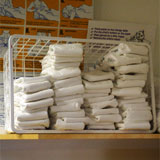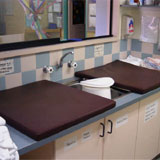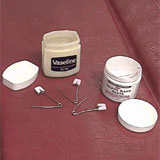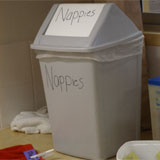Behaviour
Caring for babies
Bottle feeding
Changing a nappy
Cleaning and sterilising bottles
Daily cleaning tasks
Helping new children settle in
Preparing for a nappy change
Sleep patterns – babies
Sleep routines – babies
Toilet training
Caring for children
Allowing time for practice
Dressing/undressing
Mealtimes
Nappy change
Packing away/caring for the environment
Sleep/rest time
Toileting
Common self-help milestones
Tips for sleep and rest time
Self image
Communication
Body language
Limits and guidelines
Ways children communicate
Greeting children and families
Modelling appropriate communication
Questioning
Verbal and non–verbal communication
Acknowledging children's feelings
Listening attentively
Communicating with Aboriginal and Torres Strait Islander parents/carers
Development
Allowing time for practice
Dressing/undressing
Mealtimes
Nappy change
Packing away/caring for the environment
Sleep/rest time
Toileting
Common self-help milestones
Creative development
Language development
Modelling positive relationships
Physical development
Sharing and taking turns
Sleep patterns – babies
Sleep routines – babies
Encourage independent problem solving
Fundamental movement skills
Health, hygiene and safety
Coping with stress
Correct manual handling principles
Daily cleaning tasks
Hand washing
Hand washing poster
Manual handling overview
Toilet training
Safety checklist
Learning experiences and play
Environmentally friendly learning experiences
Learning experiences for different development areas
Creative resource materials
Arranging the environment to facilitate learning and pleasure
Indoors and outdoor areas
Creating a positive physical environment
Legal and ethical issues
Child abuse case studies
How do I recognise when a child or young person is at risk?
Tips on dealing with disclosures
Observation methods
Arranging Experiences (PDF 351Kb)
Recording observations
Rules for making observations
What you can learn from observations
Programming
Children’s interests, strengths, needs and skills
Extending the children’s interest in dinosaurs
Objective observation
Planning an OSHC environment
Behavior management plan
Planning enjoyable experiences
Planning experiences for 0 - 2 years age group
Planning experiences for 2 - 3 years age group
Planning experiences for 3 - 5 years age group
Preparing for a nappy change
When you are changing nappies, there are a number of things to consider before you can start. These include the most suitable type of nappy to use, where to change the nappy, safety of the child, and how to dispose of dirty nappies and clothing.
Type of nappy

Disposable nappies are already folded and ready to go. They come ready to use in different sizes for different aged babies. You need only have the right size and style, know which way to put them on, stick on the labels and away you go.
Cloth nappies can be either towelling or flannelette and the choice is usually a personal one. Both are folded in the same way but I'll tell you more about how to fold nappies later. There are a number of ways of securing cloth nappies, including the use of pins, velcro or plastic clips. Which you use will usually depend on the product preferred by the baby's family or the child care service you work in.
Where to change the nappy

In most cases when you're caring for children, you will have access to a change area. You will need to ensure it is hygienically clean, which means wiping down the mat that after each change with warm soapy water. If faeces or blood is dropped onto the mat, then follow the warm soapy wash with a spray and wipe of bleach. After lunch and at the end of the day, the change bench should be washed down with bleach and left in the sun to dry if possible.
Safety

Safety should always be considered while changing nappies. Keep everything that could be a safety hazard to the baby out of reach, such as all chemicals, pins and creams.
If using pins in nappies, always make sure that when they are not in a nappy they are closed and kept out of the children's reach. When pins are in use, the safety catches must be on and they should be pointing outwards on the child's body.
Many people feel that you should always wear gloves when changing nappies. The choice is yours, but you should wear gloves when changing a soiled nappy or dealing with body fluids other than urine, such as blood - this is an Occupational Health and Safety standard.
Never leave a baby alone on a change bench.
When changing a child, you must always keep one hand on them to prevent them rolling or climbing off the change bench, no matter how stable you believe the baby to be. Before you begin, make sure you have everything you need within reach so you do not need to leave the child.
Used nappies and clothing

Have somewhere to store used nappies and clothing. Nappy buckets, cloth buckets and bins are a useful idea. You should always make sure that they all have child-proof lids. If a nappy or clothing is soiled then you should sluice it before storing in the nappy bins.
Empty bins as required during the day, for example, if the bin is full or gives off an offensive odour. Empty and clean with soapy water then disinfectant or bleach at the end of the day.